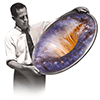This is Chapter 21 from The Man Who Mastered Gravity, now available from Amazon and fine booksellers everywhere.
(1929)
After the Gravitator patent was issued, an article appeared in the August, 1929 issue of Science and Invention magazine, with a headline that suggested that electricity and gravity had found their Faraday:
How I Control Gravitation1
by Thomas T. Brown
Writing for the first time in his own words, Brown starts with an echo of Einstein’s efforts to define the Unified Field:
There is a decided tendency in the physical sciences to unify the great basic laws and to relate, by a single structure or mechanism, such individual phenomena as gravitation, electrodynamics and even matter itself. It is found that matter and electricity are very closely related in structure. In the final analysis matter loses its traditional individuality and becomes merely an “electrical condition.”
Brown is stating that matter is a manifestation of electrical energy, extrapolating from the notion that atoms consist mostly of electrically charged protons and electrons.
In fact, it might be said that the concrete body of the universe is nothing more than an assemblage of energy which, in itself, is quite intangible. Of course, it is self-evident that matter is connected with gravitation and it follows logically that electricity is likewise connected.
The reasoning is simple: if matter is a form of concentrated electrical energy, and if large celestial objects exist within their own gravitational fields, then it “follows logically” that there is some connection between electricity and gravity.
Brown then offers a brief explanation of Einstein’s “distorted space” theory of gravitation, and addresses the question of field theories and the difficulty even Einstein has encountered in coming up with a “Theory of Combination.” But…
Einstein’s new field theory is purely mathematical. It is not based on the results of any laboratory test and does not, so far as is now known, predict any method by which an actual demonstration or proof may be made.
Dr. Einstein’s recent work has spirited the physicists of the entire world to locate and demonstrate, if possible, any structural relationship between electrodynamics and gravitation. It is not that they questioned or doubted Einstein’s reasoning or his mathematics, (for they have learned better), but that they realized that a relation should exist and were eager to find it.
Brown then claims that as early as 1923, he had discovered and “constructed the… bridge between the two then separate phenomenon, electricity and gravitation” and offers some speculation as to just where such a discover might lead:
Multi-impulse gravitators weighing hundreds of tons may propel the ocean liners of the future. Smaller and more concentrated units may propel automobiles and even airplanes. Perhaps even the fantastic “space cars” and the promised visit to Mars may be the final outcome. Who can tell?
Who indeed. But is that all there is? Plains, trains, and automobiles, maybe big boats and space cars? If we can ‘bend’ space, what, then, of time?
- 1 Science and Invention, August 1929 (image scan); full doc PDF
